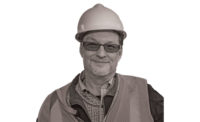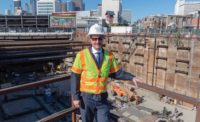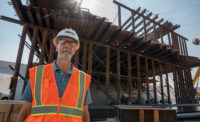
Related Article:
Intrepid Tunneling Through a Maze of Gas and Tar in LA
Back to:
25 Top Newsmakers
Considering that Richard “Dick” McLane “fell into engineering,” it seems appropriate that he ends up digging deeply into a project both literally and figuratively. That was especially the case with Section 1 of the D Line (formerly Purple Line) subway extension for the Los Angeles Metropolitan Transportation Authority. As the tunnel construction manager for the joint venture of Skanska USA Civil, Traylor Brothers Inc. and J.F. Shea Construction, McLane conducted extensive research on the history and geology of the region.
That history includes a hiatus in tunneling in Los Angeles after a 1985 explosion at a department store due to the release of methane gas. “I needed to figure out what’s going on,” says McLane, chief mechanical engineer with Traylor Brothers.
The team completed tunneling last year for its $1.64-billion design-build contract to build the first of three sections of the extension, which is on track for a 2025 completion. Crews dealt with a medley of poor soils, including tar that for millennia sucked in animals to their deaths, creating archaeological conditions; a variety of dangerous gases; and two seismic faults.
“It’s the most complex tunneling, I think, in the world,” says McLane.
But a pair of earth pressure balance (EPB) tunnel-boring machines (TBMs), a customized conveyor system, extensive monitoring and collaboration got the job done. “As a key member of the design-build team, [McLane]was instrumental and responsible for the successful planning, engineering, logistics, operation, safety, construction and collaboration with the owner of the twin-bore, 6.5-meter Herrenknecht EPB TBMs and 23 cross-passages through some of the most challenging sub-surface soil conditions experienced in the industry,” says Joseph Demello, deputy executive officer of program management with Metro. “That’s including gas and tar-impacted soils as well as mitigating subsurface anomalies which could have been detrimental to our program.”
A Taste for Tunneling
McLane earned a degree in mechanical engineering at California Polytechnic State University-San Luis Obispo, then interned with an engineering firm that designed parking garages. “After four years, I realized there was no way I could work for a design company,” he recalls. “I wanted to be hands on, in the action.”
He sent out resumes in 2005 to construction companies and immediately heard from Traylor Brothers. His first job was the Metro Gold Line extension to eastern Los Angeles County. A series of other tunneling jobs followed, including the Regional Connector for Metro, the D.C. Water’s Blue Plains Tunnel, the Sound Transit University Link Light rail project in Seattle, and the Upper Northwest Interceptor in Sacramento.
Each project deepened his affinity for tunneling. “There’s something addictive about it,” McLane says. “It’s not rocket science—but you can see [what’s around you] in space. With tunneling, you have no idea. You could have test borings every 1,500 feet, but the ground might change every 5 feet.”
With the tunneling for the D Line extension finished, McLane is now working on Phase 2 of the Valley Transit Authority’s BART rail extension to Silicon Valley—a single 16.3-meter-dia, 5-mile-long bore with three underground stations. “Every job is its own unique challenge—a new puzzle,” he says.
All ENR 2023 Top 25 Newsmakers will be honored at the Award of Excellence Gala on April 11 in New York City.






Post a comment to this article
Report Abusive Comment